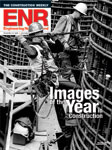I am a long-time subscriber of ENR and have always admired the best construction magazine in the business. Having said that, I hope you will not take unkindly to my following comments. I was appalled and amazed at the many safety and code violations shown in the picture on the cover of the issue, "Images of the Year in Construction" (ENR 12/27/ 04). I hope that you will contact any safety engineer of your choice and discuss this with him or her. I would also suggest this be done prior to publishing. The ironworkers gear is the worst Ive seen on any project. Only one man is wearing safety glasses, safety straps are frayed and are in sorry condition. I dont believe tire chain parts, cold shut links and such are approved for safety use to connect safe hooks to D-rings and belts. The rebar column cage is the sorriest looking mess Ive seen in a long time. I suppose these men are trying to realign the rebar and fit the splices so they can be completed, separated and not bunched. Good luck, fellows. Leaving heavy pipe wrenches, (two) and other tools so they could be knocked off and hurt someone below or wind up in the job isnt a good idea either. The wood walkway scaffolding behind the men also appears somewhat lacking for safety requirements. I have taken many construction photos over my 65-plus years in construction and have always tried to show it in the best light. Id like to comment on your article, "When Work Turns Into Art" (ENR 12/27/04 p. 18). For the most part, the most prominent person in the cover photo is not compliant with OSHA regulations. Hes not wearing safety glasses. We struggle continually with gaining compliance and commitment to safety, so it pains me to see examples of poor safety practices in the pages of our industrys leading publication. Given your status in the industry, Im afraid the message is, "If its in ENR, it must be OK." I realize your call for photography resulted in receiving photographs that were not staged, and therefore reflected whats really happening on projects. My interest is not in manipulating what the reality is, its in not reinforcing unsafe conditions and behavior. If I could wave a wand over the whole issue, I would scrub all photos, both news and advertising, in ENR for safety compliance. Im sure that I won't be the only one to critique your recent cover photo, but I wanted to make sure that you were aware of just how blatantly insensitive to current safety standards this photo makes you and ENR look. I am not a safety professional, but have worked on construction projects for the last 30 years. Even my experience in Poland, where the scaffold still had bark on it, wasnt as bad as your cover picture. I didnt get far before I noticed the following: Thank you for presenting the story of construction through photographs. It makes design and engineering come alive for readers. I have a request for the 4th annual ENR photo contest. Can we have a measure of safety for the submitted photographs that the photographers know in advance is a contest factor? In this years photos, there are many concerns for fall hazard consequences. Falls constitute 36% of construction deaths in the U.S. The number has climbed six points since 1990 while overall deaths decline, according to OSHA. It is important to know that effective fall protection methods are designed no differently than the structures that are being erected. Fall protection is an engineering science that incorporates practicality, mechanical and structural engineering, dynamic force considerations, equipment capacity, collision analysis, rescue methods, human factors engineering for anchorage points that are located appropriately, and where training is in accordance with the written erection fall protection work plan. Gorgeous composition! One of the most awesome Ive seen in years. Photographer Hewitt definitely has an excellent eye for beauty (p. 23).
|


Post a comment to this article
Report Abusive Comment